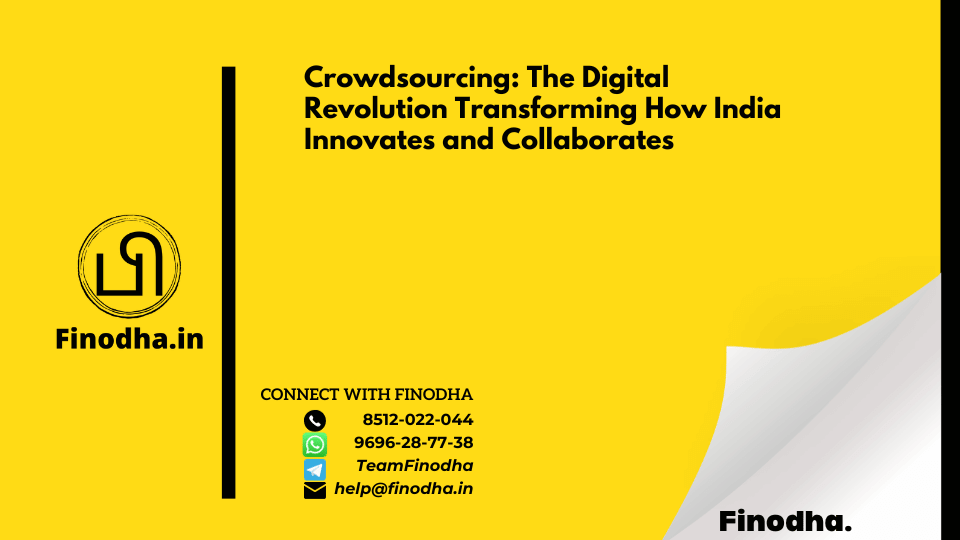Important Keywords: Crowdsourcing, India, digital transformation, innovation, collaboration, online platforms, collective intelligence.
Table of Contents
Introduction:
Crowdsourcing, a concept that came to life in the digital age, is reshaping the way we procure products, services, and ideas. It’s an innovative approach where individuals and organizations tap into the vast and diverse pool of internet users to achieve collective outcomes. In this article, we’ll delve into the world of crowdsourcing, its nuances, advantages, and how it’s changing the landscape of Indian innovation and collaboration.
In 2006, the term “crowdsourcing” was coined, but the concept had existed in various forms offline long before the digital era. Crowdsourcing encompasses a wide range of activities, from soliciting ideas and feedback to raising finances. It’s a means of distributing tasks among a collective to accomplish a shared goal.
Understanding Crowdsourcing:
One prominent aspect of crowdsourcing is “idea competitions” and “innovation contests,” where companies open their doors to ideas beyond their employees’ realm. For instance, LEGO Ideas invites enthusiasts and customers to submit designs for potential new LEGO sets. This collaborative approach allows companies to benefit from a diverse range of ideas and perspectives.
Another facet of crowdsourcing involves the completion of repetitive “microtasks” by a large, dispersed crowd. Services like Amazon Mechanical Turk enable this, where individuals can earn by performing such tasks. This approach isn’t limited to profit-seeking companies; non-profits also utilize crowdsourcing to create public goods or tackle pressing issues.
Crowdsourcing vs. Outsourcing:
It’s essential to distinguish between crowdsourcing and outsourcing. It taps into a broad, often less-focused community, while outsourcing involves contracting specific tasks to another company or party. It typically involves both bottom-up and top-down elements, and its advantages encompass cost-effectiveness, speed, efficiency, flexibility, scalability, and diversity.
The Digital Transition:
It has found a new home on the internet, which offers unique advantages. In the digital realm, individuals are more accessible, allowing them to participate in projects without geographical constraints. This leads to increased engagement as contributors can be more relaxed and open in their participation.
Moreover, the online environment fosters creativity, as contributors feel less pressure from criticism. It allows for better project customization and a focus on the unique requirements of the task rather than excessive communication.
The Advantages:
- Cost Efficiency: It often proves cost-effective compared to traditional in-house approaches.
- Speed and Efficiency: With a large and diverse pool of contributors, tasks can be completed rapidly and efficiently.
- Flexibility: It adapts to various tasks and requirements, making it versatile.
- Scalability: Projects can scale up or down as needed, without the need for fixed human resources.
- Diversity: It invites contributors from various backgrounds, leading to diverse ideas and perspectives.
The Potential Pitfalls:
- Quality Control: Managing the quality of contributions can be challenging, as participants may vary in expertise.
- Security and Privacy: Sensitive projects may encounter data security and privacy concerns when outsourced to external contributors.
- Intellectual Property: Determining ownership and intellectual property rights can be complex in crowdsourced projects.
Real-Life Example for the Indian Audience:
Imagine a small Indian startup specializing in app development. To enhance its latest project, the startup decides to use crowdsourcing to gather user interface design ideas. They create an online platform inviting designers and users to submit their concepts. This diverse range of contributors provides innovative designs, and the startup’s project is not only completed swiftly but also garners significant attention in the market.
Conclusion:
Crowdsourcing is revolutionizing how India innovates and collaborates. By embracing the power of the crowd, businesses, non-profits, and startups can tap into diverse ideas, accelerate project timelines, and improve cost-efficiency. However, it’s crucial to approach crowdsourcing with a clear strategy, ensuring quality control and addressing potential challenges. As India continues to embrace digital transformation, remains a valuable tool for driving innovation and achieving collective goals.
In a world connected by the internet, the collective intelligence of the crowd can be harnessed to solve complex problems, create innovative solutions, and drive progress in numerous sectors.
Read More: The Coasters Conundrum: Dealing with Apathetic Employees in Indian Workplaces
-
Crowdsourcing: The Digital Revolution Transforming How India Innovates and Collaborates
Crowdsourcing, a concept that came to life in the digital age, is reshaping the way we procure products, services, and ideas. It’s an innovative approach where individuals and organizations tap into the vast and diverse pool of internet users to achieve collective outcomes.
Official Income Tax Return filing website: https://www.incometax.gov.in/iec/foportal/
Official GST common portal website: https://www.gst.gov.in/

